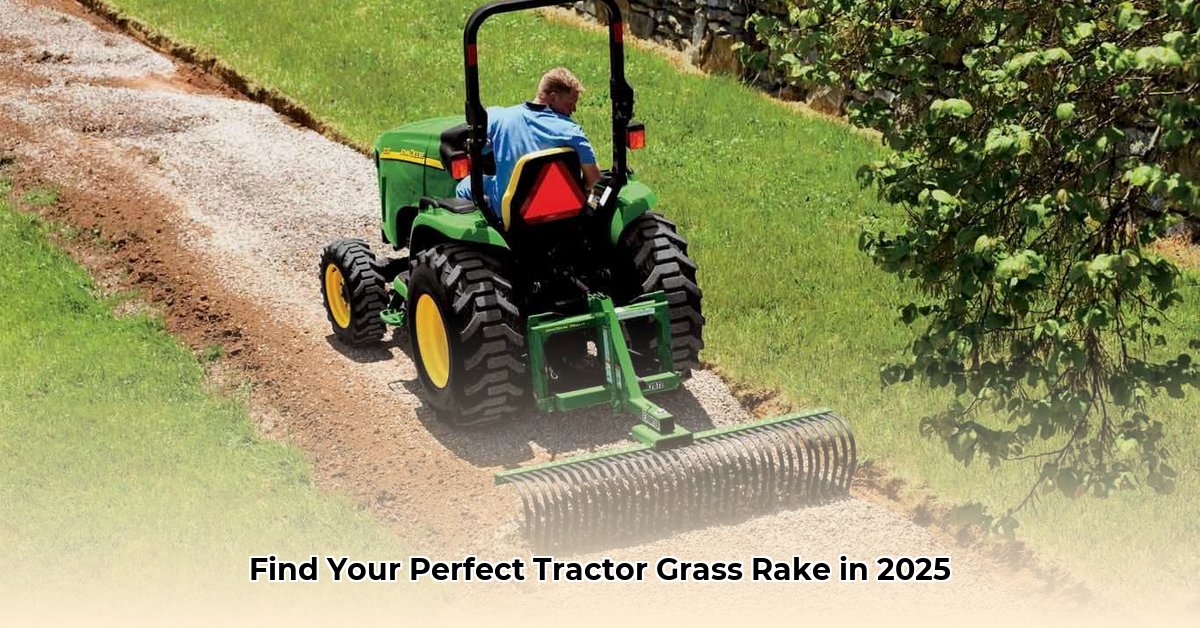
Tired of backbreaking yard work? A tractor-mounted landscape rake (a powerful tool for efficiently managing large areas of grass and debris) can revolutionize your land maintenance, whether you're a farmer clearing fields or a homeowner tackling a large yard. For more detailed information on selecting the right rake, check out this helpful guide. This comprehensive guide simplifies choosing the right rake, ensuring you get the most from your investment and enjoy smooth, efficient cleanup every time.
Types of Tractor Landscape Rakes
Tractor landscape rakes come in various styles, each suited to different needs and tasks. Understanding these differences is crucial for making an informed purchase.
Tine Design and Material
The tines (the "teeth" of the rake) are key. Their design and material dictate the rake's capabilities:
Spring Tines: These flexible tines are ideal for gentle tasks like seedbed preparation and light debris removal. They're less likely to damage the ground.
Rigid Tines: These sturdy tines are built for tougher jobs such as breaking up sod or moving heavy debris. They offer more aggressive material handling.
Tine Material: High-strength steel tines are more durable and last longer than mild steel, justifying their higher initial cost through extended lifespan.
Rake Width and Capacity
Rake width directly impacts efficiency: wider rakes cover more ground per pass. However, a larger rake demands a more powerful tractor. Overloading your tractor is dangerous and can cause damage.
Choosing the Right Rake: A Step-by-Step Guide
Selecting the perfect rake involves careful consideration of several critical factors:
1. Tractor Compatibility: Check your tractor's owner's manual for three-point hitch specifications (lifting capacity and compatibility). The rake's weight and width must fall within these limits to ensure safe operation. Do you have enough horsepower for the task? Failure to do so can lead to equipment damage or accidents.
2. Rake Width: Choose a width appropriate for your property size and tractor capacity. A larger property might benefit from a wider rake for increased efficiency; however, this necessitates the use of a more powerful tractor. Smaller properties or areas with limited maneuverability may necessitate a smaller rake.
3. Intended Use: Different tasks require different rake designs:
Seedbed Preparation: Fine, closely spaced tines are best for creating a level, consistent seedbed. Spring tines are usually preferred here for gentler material preparation.
Debris Removal: Widely spaced, potentially rigid tines are more effective for moving larger debris such as leaves, branches, and rocks.
Mulch Spreading: A rake with tines designed for even distribution is crucial for accurate mulch application. The spacing of the tines must precisely balance even distribution without bunching or compaction of the material.
4. Budget: Rake prices vary widely. While a cheaper rake might seem appealing, a higher-quality rake often offers better durability and long-term cost savings through reduced maintenance and extended lifespan. Should you prioritize cost savings or long-term value?
| Rake Feature | Budget-Friendly Option | Mid-Range Option | High-End Option |
|---|---|---|---|
| Width (feet) | 4-5 | 6-7 | 8+ |
| Tine Material | Mild Steel | High-Carbon Steel | High-Strength Steel |
| Tine Type | Spring | Spring/Rigid Combo | Rigid |
| Hitch Compatibility | Category 1 | Category 1, 2 | Category 1, 2, 3 |
| Approximate Price Range | $200 - $500 | $500 - $1000 | $1000+ |
5. Hitch Compatibility: Ensure your chosen rake is compatible with your tractor's three-point hitch system (Category 1, 2, or 3). Mismatched hitches prevent proper attachment and may cause damage. Improperly mounting the rake to the tractor's hitch could cause safety issues and significant equipment damage. Consult your tractor's manual for the appropriate hitch system.
Using a Tractor Landscape Rake: Safety and Efficiency
1. Attachment: Carefully align the rake's hitch with your tractor's three-point hitch, ensuring secure engagement. Consult your rake's manual for specific instructions and diagrams. Always double-check your connections.
2. Operation: Operate at a safe speed, avoiding sudden movements or sharp turns. Be aware of obstacles in your work area.
3. Maintenance: Regularly inspect the tines for damage, remove debris, and lubricate moving parts. The proper maintenance will drastically improve the life of your rake.
Troubleshooting Common Issues
Broken Tines: Carefully assess the damage. Replace broken tines—usually easily available—with identical replacements to restore performance.
Clogged Tines: Stop operation and clear any blockages. Frequent clogging might indicate the need for a rake with wider tine spacing.
Hitch Problems: Recheck the hitch alignment. Improper connection is almost always the culprit. Refer to both your tractor and rake manuals.
Maintenance and Storage
Clean your rake thoroughly after each use. Store it in a dry location, protected from the elements, to extend its lifespan. Regular cleaning and proper storage will greatly extend the tool's useful life.
Conclusion
Choosing the right tractor landscape rake is a decision that balances your needs, your budget, and your tractor's capabilities. By carefully following the steps outlined above, you can select a tool that will efficiently and safely handle your landscaping tasks for years to come. Remember to prioritize safety and proper maintenance to maximize your equipment's longevity and performance.